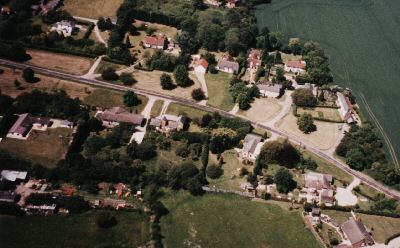|
When my husband and I came to live at The Limes in February 1961 many of the dwellings round the Green were small country cottages, much as they had been for the previous hundred years or so. The A120 was then a quiet country road along which you could get to Bishop's Stortford Station in less than 10 minutes. There were no traffic lights, no Birchanger roundabout and no road of any description where the M11 now crosses the A120. Looking down the Green from the left of The Limes across Jacks Lane, you first come to the pink house, now considerably enlarged. It was then two cottages, one inhabited by the Harrises, the other by two rather superior old ladies, the Misses Moss. The elder Miss Moss dominated her very sweet, stone-deaf sister, who never-the-less outlived her.
The next house, Homelands, was then about a third of its present size and housed Mrs Mullins, mother of Coralie Whittingham, for many years Clerk of the Parish Council. The pleasant, extensive bungalow which comes next was in those days not more than a tiny home, having been built out of bricks from a cottage burnt out some years before. Here lived Miss Annie Vale the oilman's daughter - somewhat eccentric and occasionally given to standing in the middle of the Green tossing around buckets of water which she had filled from the village pump just outside her house, and chasing away boys who had come to collect water. One very windy night her privy rose from the ground with Annie inside, scaring her badly. Members of the Parish Council were round the next day and made everything secure.
Rose Villa, the pretty pink house, was much smaller at this time and inhabited by Mr and Mrs Newman and their children. Mr Newman worked for the Electricity Board, but sadly became very ill and died, leaving Mrs Newman to bring up her family alone. At this time Rose Villa was the last house on that side of the Green. In about 1973, to the horror of the Green-dwellers, a modern bungalow appeared on the land adjacent to Rose Villa. It took some time for this "shocking new development" to settle into its surroundings.
At the end of the War a collection had been made to organise a welcome home to people coming back from the War. Under the guidance of Mr Juniper this money was used to plant fine trees around the Green, which have now grown up and gladden the Green with their flowers in spring.
Working back from the main road on the west side we arrive at The Croft, originally called Elm Cottage and previously the official residence of the Warish Hall gamekeeper. In 1961 it was smaller, weather-boarded and inhabited by the Haynes family who first arrived in 1951. The late Harry Haynes is Smiths Green's main celebrity, having been awarded the OBE for his work for the National Farmers Union.
On to Moat Cottage. In the fifties it had been bought by Geoff Allen, a friend of the Kray twins, who were in the habit of visiting the house. It was lived in by Allen's mother, a very unfriendly red-haired woman with a past. Allen was responsible, with accomplices, for burning down a number of local mansions and collecting the insurance. Eventually he was caught and sent to prison having bought, in someone else's name, and destroyed, Shortgrove House, a very fine Georgian mansion in Newport, which sadly has never been rebuilt.
In 1961 the pretty white thatched house, now called just "The Cottage" was in fact two cottages, inhabited on one side by the Spurgeons (the story goes that Mrs Spurgeon's very large ginger cat would climb in through her bedroom window and present her with a rat or a rabbit). On the other side lived Mrs Sneath, an invalid but always friendly and cheerful. Next comes the delightful well-appointed Beech Cottage. In 1961 this was a small weather-boarded cottage painted in cream and brown, where lived Miss Wisbey - a famous much-loved Takeley character. She played the organ, ran the Church choir, taught at the High Roding School, had been a founder member of the Dunmow Handicap Club and in her spare did the Charltons' mending.
The architectural style changes as we come to the small Victorian terrace of four cottages (now two) called South Cottages. There is some argument as to who lived in which cottage and when, but I know from my own experience that one inhabitant was Bernie Keel, a somewhat mysterious gypsy-like person. He helped us civilise The Limes (which had been empty for eleven years when we arrived) and worked in Broxted on Mr Waterfield's beautiful garden at Hill Pasture, which featured in Country Life. 'In another cottage lived Joe Garrett, owner of a very fine racing bicycle on which he made prodigious journeys. He worked part-time as houseboy to the Misses Moss. In a third cottage (possibly at a slightly earlier date) lived Mrs Bolden whose friend used to bring her goats from Broadfield Road to graze on the Green. In the fourth cottage lived Widow Humphries and her children. In the Fifties the whole row was condemned and rebuilt as two modern houses.
Behind South Cottages lies Goar Lodge, weather-boarded and much as it was in 1961. At that time it housed the Warish Hall Farm Manager. Close by at one time ther4--stables, in a weather-boarded building with cobblestone floor and stalls for horses. This was converted to workshops and had become, by 1961, Mr Juniper's little factory for testing bird-scarers It is now a quiet, cosy little cottage.
Finally we come to Bull Cottages, originally a pub called The Bull, which was converted by Mr Juniper to two farm cottages. One of these has been the long time home of the Jolly family. The garden has always been, and still is, a haven for birds and was very recently visited by a pair of longtailed tits. The second cottage was the home of Mr and Mrs Bert Reynolds for 43 years. They both worked at Warish Hall and Bert created an immaculate and thriving garden round his cottage. After Bert's death, Ann and son David moved to Priorswood Road.
I have collected this information from my friends who were living on or around Smiths Green when we moved to The Limes in 1961. These stories may have been confused, exaggerated or incorrectly remembered but they belong to Smiths Green.
June Bethell-Fox

This Photograph of Smith's Green was taken in 1997 but apart from the size of the trees little has changed since the time described.

|



